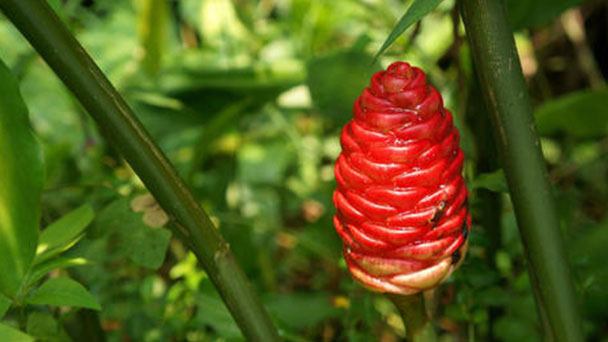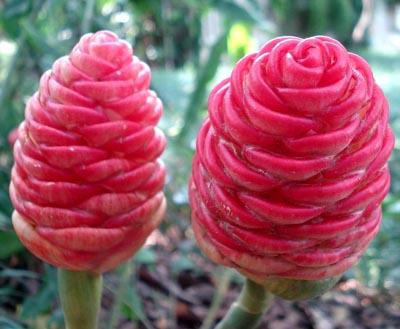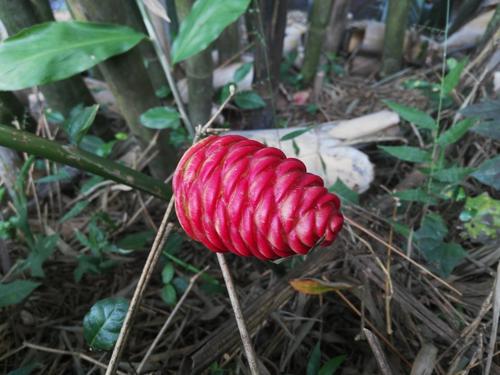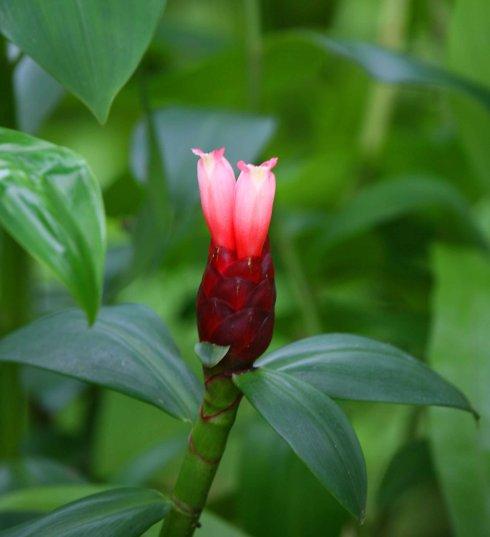Bitter Ginger (Zingiber Zerumbet) Profile: Info & Care Guide
Written by Maggie
Nov 03 2021

Bitter Ginger (Zingiber zerumbet), also called Pinecone ginger, Shampoo ginger, Pinecone lily, Wild ginger, Awapuhi (in Hawaii), Lampoyang (in Malaysia and Indonesia), is mainly distributed in tropical Asia. India to the Malay Peninsula and other places, domestic Taiwan Province, Hainan Province, Guangdong Province, Guangxi Autonomous Region are distributed.
Bitter Ginger likes semi-shade, warm climate and acid soil with good drainage. bitter ginger has high ornamental and medicinal value.
Bitter Ginger Picture

Bitter Ginger Characteristics
Bitter Ginger has a lumpy root. Leaves into two columns, leaf sheath holding stem. Leaves are oblong-lanceolate. Spices are borne at the apex of the flower stem, sub oblong, cone-shaped. Bracts are dense, imbricate, green when young, later turning red. Florets with slender corolla tube, eaves 3-lobed, white.Flowering in summer and autumn. Rootstock is massive, inside light yellow; Plant height is 0.6-2 meters.
Leaf blade of Bitter Ginger is lanceolate to oblong-lanceolate, 15 -- 40 cm long, 3 -- 8 cm wide, glabrous or abaxially sparsely pilose; Sessile or with a short stalk; Ligule is 1.5-2 cm long. Total pedicels are 10 -- 30 cm long, covered with 5 -- 7 scaly sheaths; Inflorescences are globose, apically obtuse, 6 -- 15 cm long, 3.5 -- 5 cm wide; Bracts are imbricate, compact, suborbicular, 2 -- 3.5 cm long, pale green at first, later reddish, margin membranous, pubescent, often containing mucus; Calyx of Bitter Ginger is 1.2-2 cm long, membranous, dehiscent on one side; Corolla tubes are 2 -- 3 cm long, slender, lobes lanceolate, pale yellow, posterior one long, 1.5 -- 2.5 cm long; Lower sepal is pale yellow, central lobe suborbicular or subobovate, 1.5-2 cm long, 1.5 cm wide, apical 2-lobed, lateral lobes obovate, ca. 1 cm long; Stamens are 1 cm long, connective appendages beaked, 8 mm long. Capsule of Bitter Ginger is elliptic, 8-12 mm long; Seeds are black.
Bitter Ginger Native Habits
Bitter Ginger (Zingiber zerumbet) likes semi-shade, warm climate and well-drained acidic soil. Bitter Ginger is a semi-shade loving plant, which grows in the shade and wet place under the forest and is suitable for growing in all kinds of soil. It is best to grow in the fertile and well-drained loam or sandy loam and humus soil.
Bitter Ginger is fond of warm and hot climate, and the plant is sensitive to strong light. The plant is fond of sun and tolerant to half shade environments, and the optimal growth temperature is 22-30 ℃. After November, when the temperature is below 20℃, the plant grows slowly or stops growing, and the aboveground parts begin to wilt and wither.Winter dormancy, can cut off the ground branches and withered leaves, the soil to maintain a semi-humid state, should not be too dry. Bitter Ginger begins to bud in March of the following year. It can grow well under high temperature conditions above 35°C, but it should have sufficient water supply, otherwise the flower stem will shorten and the plant will be wilting, but it is afraid of stains and water will easily cause rot of the rhizome. The whole growth period requires a more appropriate fertilizer and water supply, must not be too much fertilizer and water, otherwise cause the plant to grow, underground department no longer moss flowering, seriously affect the yield.
Bitter Ginger is sensitive to fertilizer, and will reduce the yield of cut flowers when there is sufficient fertilizer in the early growth stage. In order to promote the growth of tubers, more topdressing can be used, but as a cut flower, fertilization methods should be mastered. Under normal circumstances, when the new bud grows 3 ~ 4 leaves to top dressing once, decomposed organic fertilizer is appropriate, 1000 kilograms of acre. After depending on the soil fertilizer, topdressing 1 ~ 2 times, when the flower stem to 10 cm long can be applied once, for inflorescence growth; In winter, after the death of the ground, it is applied again to promote tuber growth. The elongation of flower stems has a great relationship with air humidity. High planting density and excessive dryness are not conducive to the growth of flower stem elongation.
Bitter Ginger Care
Size & growth
With a clumping increase habit, Bitter Ginger normally grows about 4’ ft tall, however, in some cases, it is determined to develop up to 6′ to 7’ toes tall.
It's reed-like, erect stems upward jostle up to 4' ft and are clumped by means of sheaths of 8” inches long, slim leaves.
The inflorescence grows 2” to 4” inches in length.
Flowering & Fragrance
Bitter Ginger is a broad-leaved plant that produces showy blooms on flower stalks in summer.
In spring, 9 to 12 blade-like inexperienced leaves show up on the underground stem.
By mid to late summer, the thick shampoo ginger rhizomes produce flower spikes topped with a globular, brightly-colored inflorescence.
An inflorescence is at the start wrapped with the aid of green, waxy bracts, which flip a shiny color of crimson upon attaining maturity.
Bitter Ginger resembles a pine cone and has a fresh, aromatic, ginger-like scent.
The pinecone-shaped inflorescence produces tiny tri-petaled plants in colorations of yellow and is full of fresh-smelling, bitter-tasting, creamy white sap.
Light & Temperature
Bitter Ginger is iciness hardy to the USDA hardiness zones eight thru 10.
They choose tropical or subtropical climates, however additionally develop in moderate climates on the mainland.
In chillier climates, pinecone Bitter Ginger is grown indoors.
The best temperature for these unusual vegetation is 32° stages Fahrenheit (0° C) or higher.
Bitter Ginger revels in full solar to section shade.
Watering & Fertilizer
Bitter Ginger must be seasonally waterlogged.
Water them with free-draining soils all through the hotter months and hold them dry at some point of the dormant wintry weather months.
Similarly, fertilize shampoo ginger vegetation with an all-purpose fertilizer throughout the summer season only.
Supply phosphorus-rich fertilizer via the quit of the developing season to make certain wholesome and well-grown rhizomes.
Soil & Transplanting
Pine cone Bitter Ginger prospers in filtered coloration and wealthy soil.
It prefers soil with an impartial pH and a mild to medium texture.
In summer, furnish the plant with persistently moist soils and preserve the soil dry in the course of winters due to the fact that the plant goes dormant and requires much less moisture.
While the Bitter Ginger suggests gorgeous tolerance for terrible sandy soil, tough soils want to be adjusted by way of including gypsum earlier than planting the plant.
Bitter Ginger is cultivated via seeds and rhizome extracts.
Transplant the Bitter Ginger by way of harvesting new shampoo ginger rhizomes 10-12 months after planting, ideally in late wintry weather or early spring.
Pruning
Bitter Ginger is a forgiving and fast-growing perennial which can unfold throughout a backyard inside years beneath perfect conditions.
In USDA Zone 8, Bitter Ginger live to tell the tale wintry weather when mulch is delivered to the soil and the roots and rhizomes are blanketed from freezing.
However, in areas positioned in the north of Zone eight up to Zone 10, the rhizomes need to be picked up and overwintered indoors.
Also, potted plant life needs to be stored indoors, away from the frost, when temperatures fall beneath 55° stages Fahrenheit (13° C).
Snip the leaves which die to the floor after the first frost.
Keep an eye out for pests and, if infested, spray with a robust water jet and follow plant-based horticulture oil on the leaves.
Do now not observe oils when the local weather is warm and humid.

Bitter Ginger Propagation
Plant propagation occurs when new shoots occur in spring. Bitter Ginger mainly propagates asexually, and there are two propagation methods, namely, dividing the side buds from the mother plant into independent plants and cutting the tuber into a small piece by digging up 2-3 buds in spring.
Bitter Ginger Disease Control
Bitter Ginger (Zingiber zerumbet) basically had no harm from diseases and insects during the whole growth period, and mainly prevented the snail, snail and mole crickets from eating underground tubers, etc. In addition, attention was paid to preventing the underground tuber from rotting caused by water accumulation.
Bitter Ginger Distribution
Bitter Ginger is mainly distributed in tropical Asia, India to Malay Peninsula and other places.
Bitter Ginger is produced in Guangdong, Guangxi, Yunnan and other provinces; Bitter Ginger was born in the shade of the forest wet, widely distributed in tropical Asia. Bitter Ginger is distributed in southern China and eastern Guangdong, as well as from India to Malay Peninsula.
Bitter Ginger Uses
Ornamental value
Bitter Ginger has a peculiar inflorescence shape and can be used for viewing. Bitter Ginger can blossom many small white flowers every day in the early stage, but the viewing value is not high. The best viewing period is when all the bracts turn bright red, which looks like a ball of fire far away.
Bitter Ginger Several small yellow flowers appeared in bracts on pale green globose inflorescences in summer, and gradually turned into red cones in autumn. It looks like a red candle and a ball of flame, so it gets its name.
Medical value
Bitter Ginger tastes like ginger at first, then turns Bitter and can be used as a flavor for ginger.

Latest Updated
- Benefits of Bugleweed - 7 Science-backed Health Benefits
- Bugleweed Dangers & Side Effects - Is It Poisonous?
- How to Plant Evergreen Trees - What You Should Know
- When to Plant Evergreens - Grow Guide for Evergreen Trees
- 12 Wonderful Evergreen Shrubs for Your Garden
- 12 Popular Evergreen Plants with Pictures for Beginners
- When And How To Prune A Lilac Bush Like a Pro
- How to Grow & Care for Lilac Vine (Hardenbergia Violacea)
- Japanese Lilac Tree (Syringa Reticulata) Care & Propagation Guide
- Shumard Oak Pros and Cons - What to Know
Popular Articles
- Winter maintenance of Antirrhinum Majus
- How to Grow Terminalia Mantaly Tree
- How to Grow and Care for Crossostephium Chinense
- How to grow Antirrhinum Majus in spring
- Peristeria Elata (Dove Orchid) Profile: Info & Care Guide
- Underwatered Snake Plant (Sansevieria Trifasciata) - Signs And How To Fix
- How to Care for Brazilian Jasmine Plant (Mandevilla Sanderi)
- How to Grow & Care for Graptopetalum Purple Delight in Summer
- Rosa Chinensis (China Rose): Plant Growing & Care Tips
- How to Care for Baby Sun Rose (Aptenia Cordifolia)